The amazing story of the Olympic flame
It has been right around the world, gone into space and scaled Everest. Over the last 80 years, the Olympic torch has been carried by hundredsof thousands of people and travelled on every imaginable form of transport, though mostly by foot. Here, werecount the epic tale of the Olympic torch relay.
The Olympic flame made its first appearance of the modern era at Amsterdam 1928, where it was lit atop a toweroverlooking the Olympic Stadium, the venue for the athletics events. It also presided over the scene at LosAngeles’s Olympic Stadium four years later, this time at the top of the gateway to the arena, whichresembled the Arc de Triomphe.
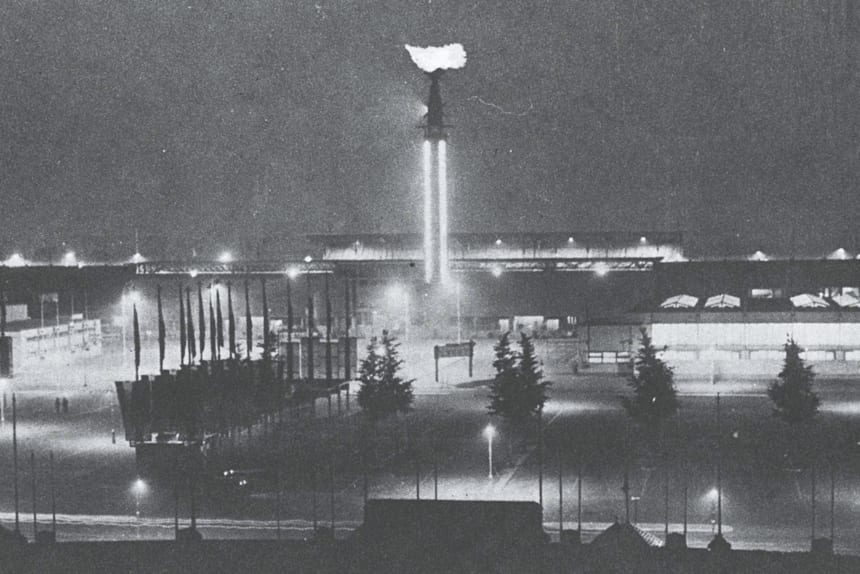
It was not until Berlin 1936, however, that the Olympic torch relay – the brainchild of the universitylecturer and sports theorist Carl Diem – was first staged. As continues to be the custom today, the flamewas lit in Olympia, Greece, in the same way as it was in ancient times, with the aid of a parabolic mirrorreflecting the sun’s rays. Attending the lighting ceremony was Pierre de Coubertin, the founder of themodern Games, who wished the runners taking part in the inaugural relay every success.
The idea of using a torch to transport the flame was not adopted straightaway. Taking inspiration from ancientways, the Organising Committee of the Berlin Games had initially planned to convey the flame by means of a bundleof slow-burning fennel stalks. For practical reasons, however, it was finally decided to use a torch for the job,with the Organising Committee requesting the creation of a specific design, given that there were no torches onthe market capable of meeting their criteria.

The first torchbearer on that maiden Relay was the Greek Konstantinos Kondylis, with Germany’s FritzSchilgen the 3,075th and last. On its journey between Olympia and Berlin, the torch made its way throughBulgaria, Yugoslavia, Hungary, Austria and Czechoslovakia, finally reaching the Olympic Stadium on 1 August1936.
In the years that followed, the story of the Olympic flame began to unfold like an epic novel, with eachOlympiad producing its own unique tales, played out by a cast of hundreds of thousands of runners over distancesboth great and small and on every possible form of transport.
For its part, the London 1948 Torch Relay was completed almost entirely on foot, with 1,416 torch-bearerscarrying the flame from Olympia to Corfu and on to Italy, from Bari in the south to Milan in thenorth.
After crossing the Swiss border it reached Lausanne, where a special ceremony was held before the tomb of DeCoubertin. From there the flame travelled on to eastern France, Luxembourg, Brussels and Calais, taking a boatacross the Channel, disembarking in Dover and finally reaching London on 29 July. The final leg of the Relay sawit being carried from Wembley Stadium, where the cauldron was lit, to Torquay, the venue for the sailingcompetitions.
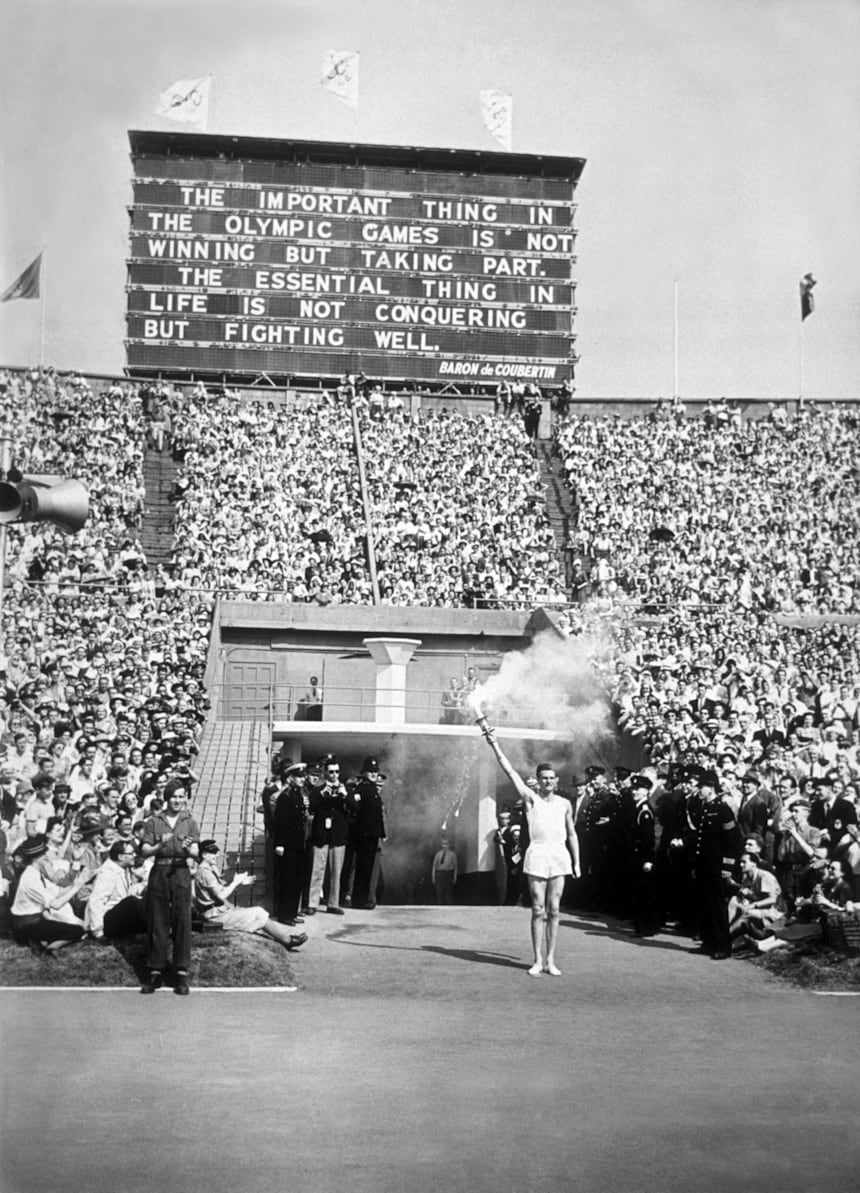
The flame goes global
The flame went airborne for the first time on the Helsinki 1952 Torch Relay, flying to the Danish city ofAalborg following an initial journey between Olympia and Athens. After making its way across Denmark and intoSweden, it passed through Gothenburg and Stockholm and then crossed the Finnish border at Tornio. From there itwas borne to Tampere and on to Helsinki, the final destination of a 7,492 km journey involving a grand total of3,042 runners, the last of them being Hanne Koelhmainen, a multiple Olympic track and fieldmedallist.
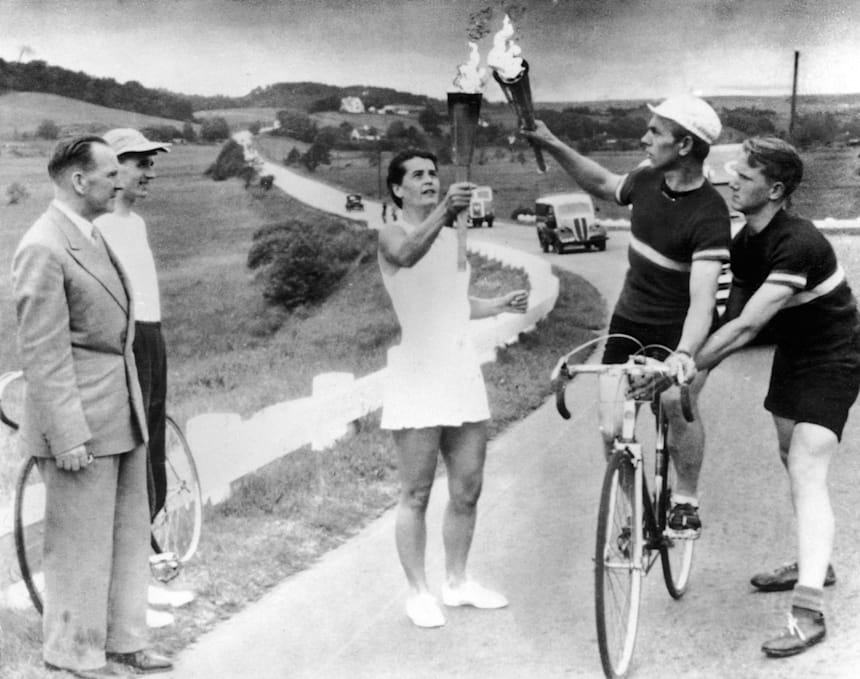
The Melbourne 1956 Torch Relay was unique in two ways. Firstly, it was the first to venture into the southernhemisphere, travelling from Singapore to Djakarta before taking to the air and calling in at a number of citiesaround Asia. On reaching Darwin, it flew on to Cairns and was then carried all the way along the Pacific coast toMelbourne. Secondly, with the equestrian events being held in Stockholm that year, a separate relay took theflame from Olympia to Athens, from where it was flown to Copenhagen, Malmo and on to the Swedish capital, where,for the one and only time in Olympic history, a second cauldron was lit, a small matter of 15,600 km away fromMelbourne.
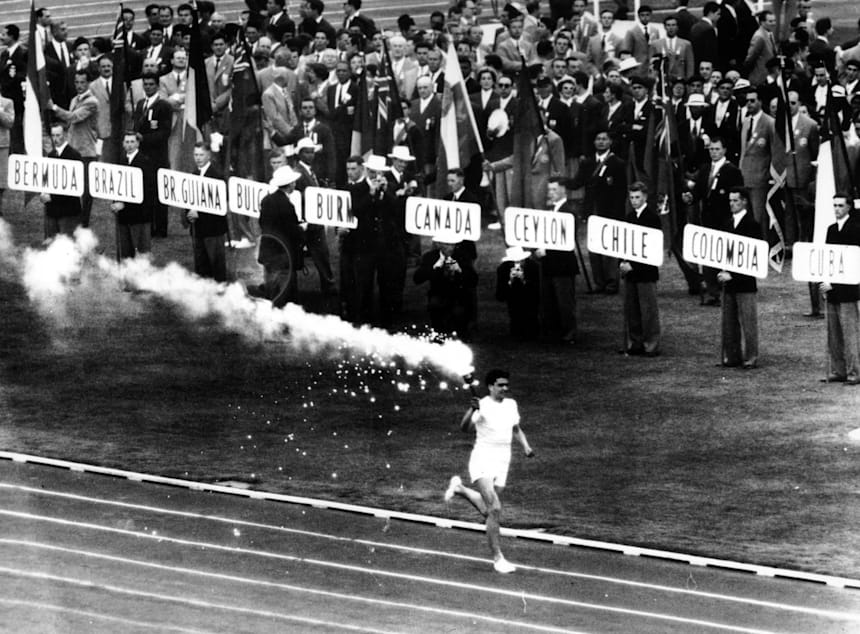
Taking centre stage in the Rome 1960 Torch Relay were a number of ancient sites in Greece, Sicily, ReggioCalabria, Taranto, Naples and Rome, the idea being to put the spotlight on the Greek and Roman civilisations andhighlight the link between the modern and ancient Games. This was also the first relay to be televised.
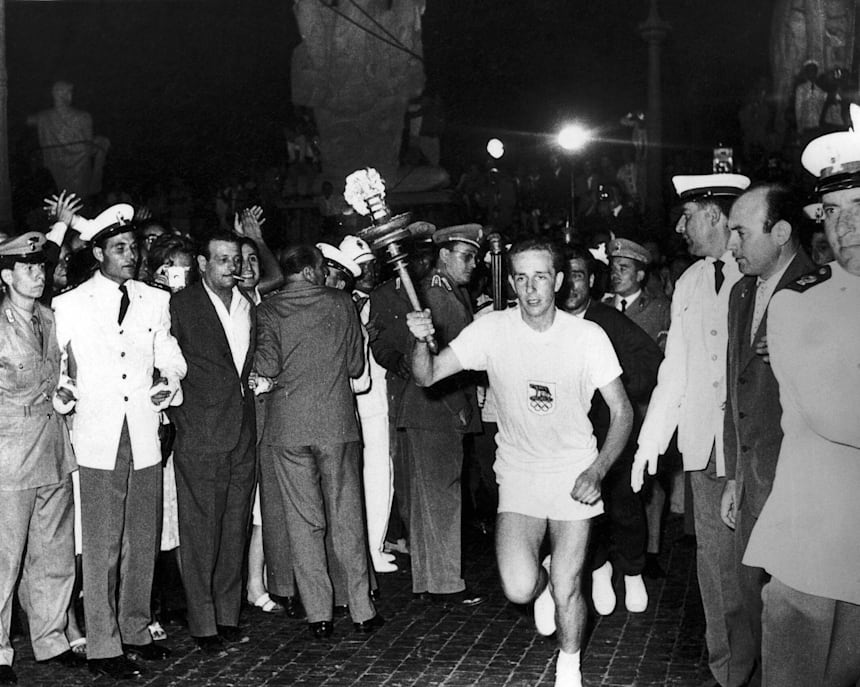
Following stages in Istanbul, Beirut, Tehran, Lahore, New Delhi, Kolkata, Rangoon, Bangkok, Kuala Lumpur,Manila, Hong Kong and Taipei, the Tokyo 1964 Torch Relay bore the flame to Okinawa, the largest of Japan’ssouthern islands. Its next destination was Kagoshima, situated at one end of the country’s main island ofHonshu, at which point it branched off in four different directions, covering the whole of the country, all theway up to Chitose, on the island of Hokkaido.
Finally, on 9 September 1964, the last torch-bearers came together in front of Tokyo’s Imperial Palaceto light a cauldron, with a final leg then taking the flame to the city’s Olympic Stadium, where the honourof lighting the Olympic cauldron went to Yoshinori Sakai. Nicknamed “Baby Hiroshima” on account ofhaving been born in the southern city on 6 August 1945, the day the atomic bomb was dropped there, Sakai was afitting choice as the final torch-bearer, symbolising, as he did, both peace and hope.
The Mexico City 1968 Torch Relay used four different torches and was inspired by the adventures of the Genoa-born Christopher Columbus, the first explorer from the western world to set foot in the New World, which he“discovered” it in the name of Isabella Queen of Spain in 1492. Following the now-traditional stagebetween Olympia and Athens, the flame arrived in Genoa, where a ceremony was held in front of the house whereColumbus lived. Its next port of call was Barcelona, the legendary explorer’s destination on his returnfrom the Americas.
The flame was carried across Spain to Palos, from where Columbus set sail westwards on 3 August 1492. The lasttorch-bearer on this section of the Relay was a direct descendant of his by the name of Cristo¥bal Colo¥n deCarbajal. After crossing the Atlantic, the flame arrived in San Salvador in the Bahamas, where Columbus firstlanded, believing he had arrived in the Indies via a new sea route.
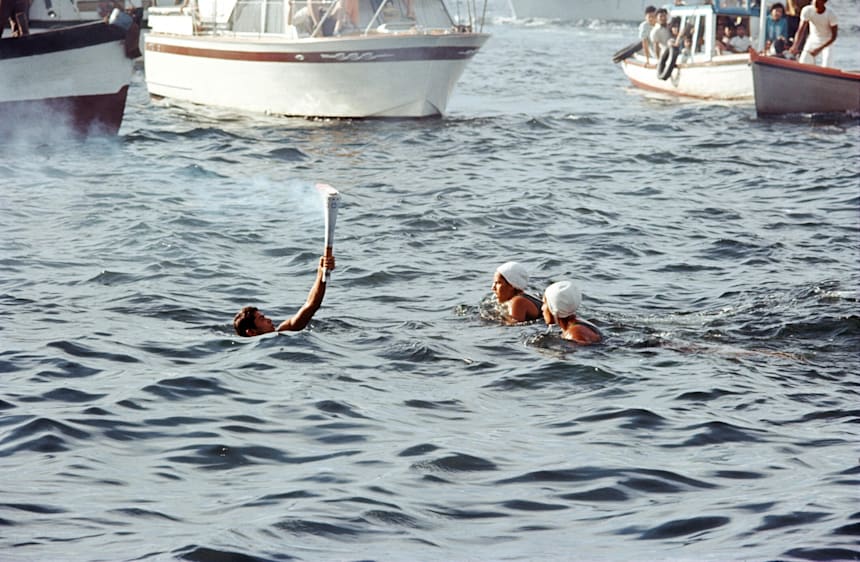
From there the Relay moved on to Veracruz in Mexico, passing through Teotihuacan, the largest city in thepre-Columbian Americas, where a ceremony was staged in front of more than 50,000 spectators. Finally, on 12October 1968, the cauldron was lit at Mexico City’s Olympic Stadium by the athlete Enriqueta BasilioSotelo, the very first time in the history of the Games that a woman was given the honour of doing so.
From Munich 1972 to Seoul 1988
On 28 July 1972 the flame set off from Olympia for a Relay that would cover 5,532 km and involve 6,200 torch-bearers. Its final destination was Munich, the host city of the XX Olympiad of the modern era. En route it tookin Athens and Thessaloniki, made a detour to Istanbul and then headed to Germany via Varna in Bulgaria, Bucharestin Romania, Belgrade in Yugoslavia, Budapest in Hungary and Vienna in Austria.
The flame also stopped off in Innsbruck and Garmisch-Partenkirchen, both of them former Winter Games hostcities. It was eventually greeted in Munich at a special reception ceremony at the Ko®nigsplatz, attended by20,000 spectators. Representing Europe at the Opening Ceremony, the final torch-bearer, Gu®nther Zahn, was joinedby runners from the four other continents: Kipchoge Keino (representing Africa), Jim Ryun (America), KenjiKimihara (Asia) and Derek Clayton (Oceania). Separate flames were then carried to Kiel, the venue of the sailingevents, and Augsburg, where the rowing competitions were held.
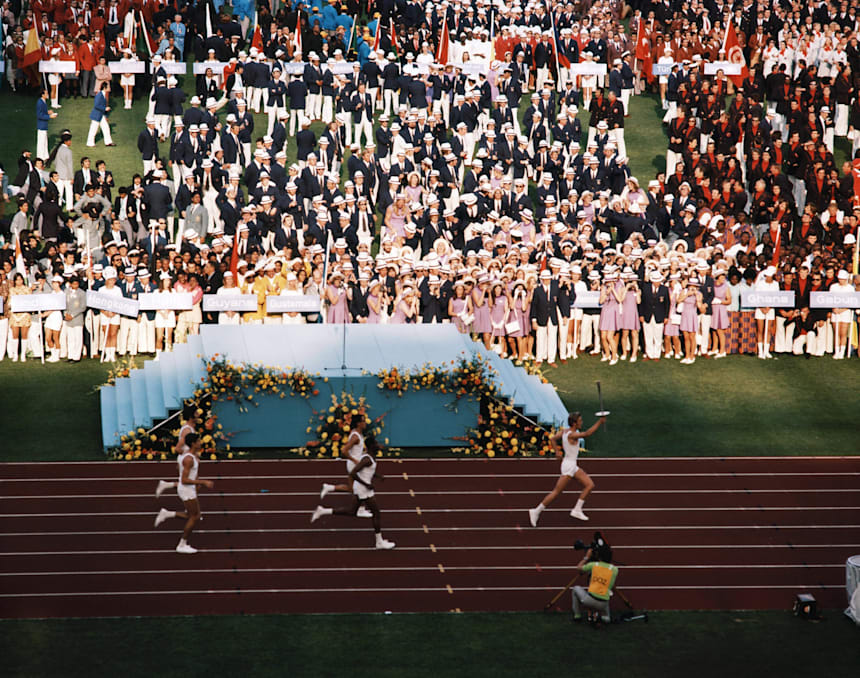
The Montreal 1976 Torch Relay saw an amazing technological development. On the evening of the flame’sarrival in Athens from Olympia, a ceremony was staged at the Panathinaiko Stadium, where the flame was positionedin front of a sensor that detected ionised particles from it. Converted into encoded impulses, they were thensent them via satellite to Ottawa. On the arrival of the signal in the Canadian capital, a laser beam reflectedon a parabolic mirror recreated the flame in its original form in a cauldron situated on ParliamentHill.
The first kilometre of the Canadian section of the Relay was completed by 12 runners representing the tenprovinces and two territories that formed the country at the time, each of them carrying a torch with the flame.At the end of their legs, the 12 runners came together and passed the flame on to another runner.
In making its way from the capital to Montreal, the Relay flanked the Ottawa River, passing from one bank toanother along the way. The flame’s arrival at the Olympic Stadium saw another piece of history, with twopeople lighting the cauldron for the first time: Sarah Anderson, an English-speaking Canadian from Toronto, andStéphane Préfontaine, a French-speaking compatriot from Montreal.
Starting on 19 June 1980 in Olympia and reaching its conclusion on 19 July at Moscow’s Lenin Stadium,the Torch Relay of the XXII Olympiad was completed entirely on foot and took a northerly route, with some 5,435torch-bearers ferrying it safely through Greece, Bulgaria and Romania, and a crowd of 40,000 turning up to see itin Bucharest. The Olympic flame entered the Soviet Union at Chisinau, on the Romanian border, and made its way upto Moscow via Kiev and Belgorod. On the very eve of the Games, a cauldron was lit in Sovietskaya Square, withfour separate torches then being lit and carried to the subsites of Tallinn, Leningrad, Minsk and Kiev.
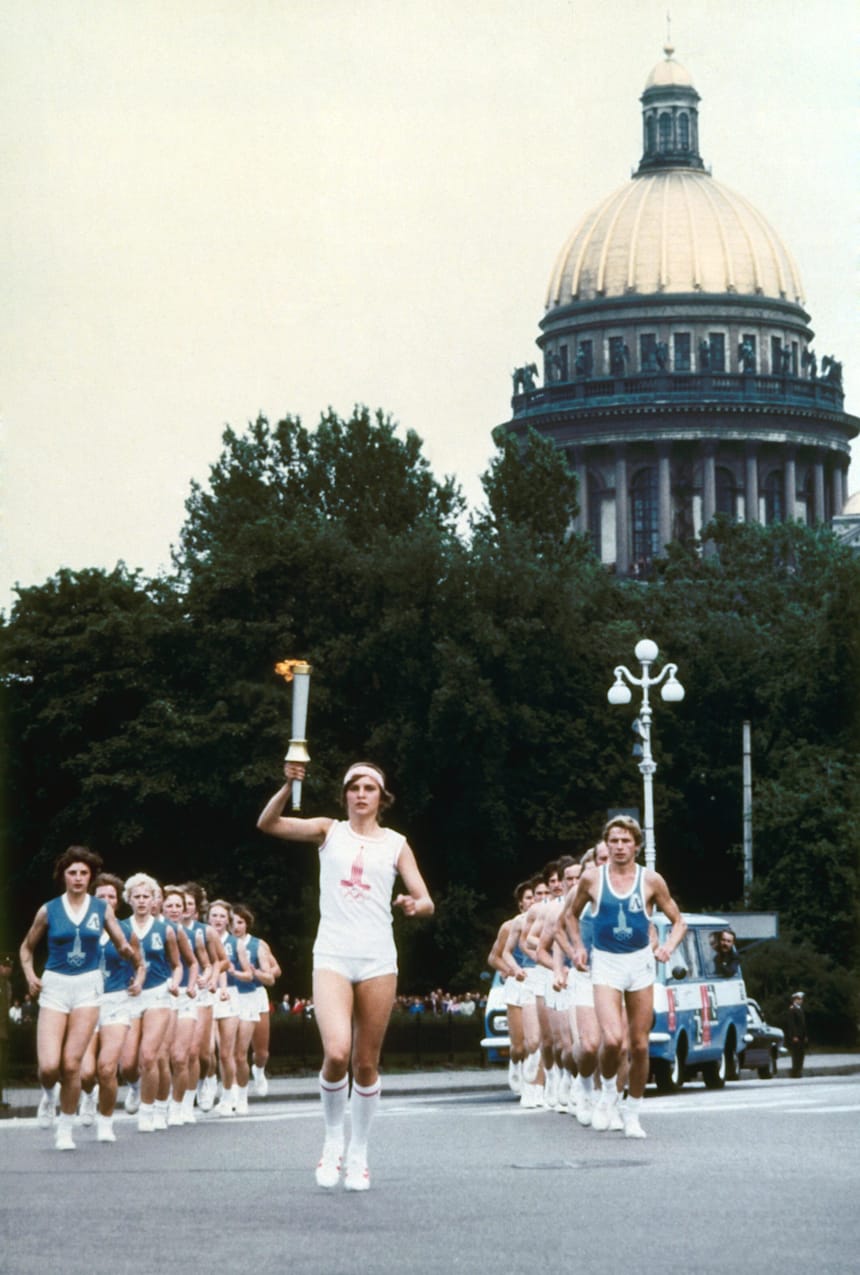
The Los Angeles 1984 Torch Relay crossed the United States from east to west on a winding, 15,000-km route.Lit in Olympia on 7 May, the flame flew to New York 24 hours later. Waiting for it there, in front of the UnitedNations Headquarters, were the Relay’s first two torch-bearers, Gina Hemphill and Bill Thorpe Jr,respective descendants of the legendary athletes Jesse Owens and Jim Thorpe. In the weeks that followed the flamewas carried through 33 states in all, as well as Washington D.C.
After moving through the south, from Dallas to Texas, and heading as far north as Seattle in Washington State,the flame arrived at the Los Angeles Memorial Coliseum for the Opening Ceremony on 28 July 1984, where the 1960Olympic decathlon champion Rafer Johnson climbed 96 steps to light the cauldron. The very same cauldron that hadbeen used at the 1932 Games – also held in the Californian city – it stood over 45 metreshigh.
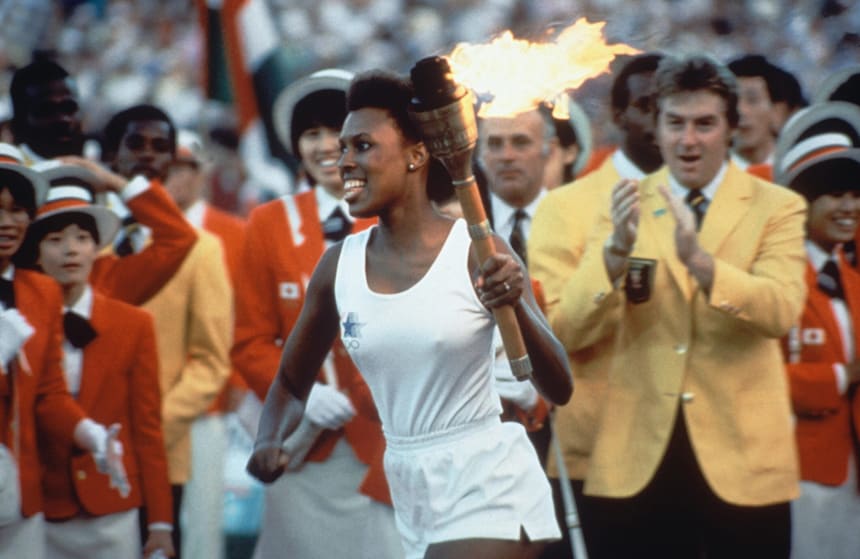
After making the journey from Greece to Bangkok ahead of Seoul 1988, the flame arrived on Korean soil on theisland of Jeju, to the south of the peninsula, from where it sailed to the port of Busan on a ship named Olympia88. Involving 1,467 people of all ages, among them celebrities, artists and athletes, the Torch Relay thatfollowed saw the flame travel right across the Republic of Korea on foot and by car, bike, motorbike and horse ona zigzagging route from east to west and north to south, finally arriving in Seoul in the suburb ofIncheon.

Held on 17 September at the city’s Olympic Stadium, the Olympic Ceremony saw the last three torch-bearers – Won Takkim, Sun Manchung and Mi Chungsohn – lifted 22 metres into the air on a specialelevator in order to light the cauldron, which measured 5.5 metres in diameter and was perched on top of aneight-sided pole.
Relay goes galactic
No one who saw it could ever forget the lighting of the cauldron at the Opening Ceremony of Barcelona 1992,held on 25 July. Taking up position in the centre of the Montjuic Olympic Stadium, Paralympic archer AntonioRebollo took hold of a burning arrow lit by the flame and fired it at the cauldron, setting light toit.
Prior to that memorable moment, the Barcelona Torch Relay had seen the flame travel from Olympia to Athens andthen hitch a ride on the frigate Catalun~a all the way to the ancient Greek settlement of Empuries, in Catalonia.Covering a distance of 5,940 km, a total of 9,484 torchbearers (8,885 runners and 599 cyclists) then took thetorch through 652 cities, towns and villages, including the capitals of the Spain’s 17 autonomous regions.The Relay also took in the Canary Islands and the Balearics.
Atlanta 1996 marked the centenary of the modern Games, a landmark celebrated by the initial relay from Olympiato Athens, which was followed by a ceremony at the Panathinaiko Stadium, where representatives of the host citiesof the 17 previous Olympic Summer Games each received a lamp containing the Olympic flame, which they duly tookhome with them so that tribute could be paid to it.
The starting point for the American leg of the Relay was Los Angeles, from where it embarked on a 26,875-kmjourney around the country, with some 12,467 torchbearers taking part. The Atlanta 1996 Torch Relay also saw theflame go into space for the first time, aboard the shuttle Columbia. Following its return to Earth, boxing greatMuhammad Ali provided the highlight of the Opening Ceremony at the city’s Olympic Stadium on 19 July 1996,taking hold of the torch and lighting the cauldron with it.

What made the Sydney 2000 Torch Relay unique was the fact that it took place mostly at sea, with the torchvoyaging from one Pacific island or nation to the next en route to Australia: from Guam to New Zealand, fromPapua New Guinea to the Cook Islands, from Micronesia to Tonga, and from Vanuatu to Samoa. In late June thatyear, the flame even went beneath the waves for an underwater leg at the Great Barrier Reef. A special torch alsowent up into space, with the shuttle Atlantis conveying it all the way to the International SpaceStation.
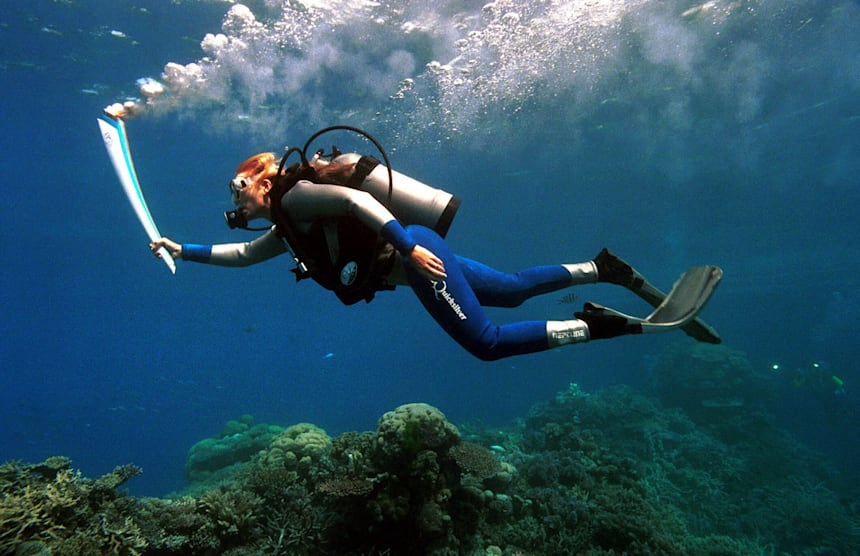
When it finally reached Australia, 11,000 torch-bearers took it on a tour of the entire country. In thecrowning moment of the Opening Ceremony at the Olympic Stadium on 15 September 2000, the 100th anniversary of theadmission of women to the Olympics was marked by the appearance of seven of Australia’s greatest femaleathletes. Bethy Cuthbert, Raelene Boyle, Dawn Fraser, Shirley Strickland, Shane Gould and Debbie Flintoff-Kingeach took turns to carry the torch before Indigenous Australian track and field star Cathy Freeman completed thevery last leg, climbing a flight of steps, stepping into a circular pool of water and light a ring of flame,which then rose into the air above her, as fireworks soared into the Sydney night sky.
The Torch Relay that hailed the return of the Games to Athens in 2004 was the first to go right around theworld, across the five continents, mirroring the five Olympic rings. Its numerous ports of call included all thehost cities of the modern era, a host of the world’s other great cities and, in a first for the relay,Africa, with the torch travelling between Cairo in the north and Cape Town in the south.
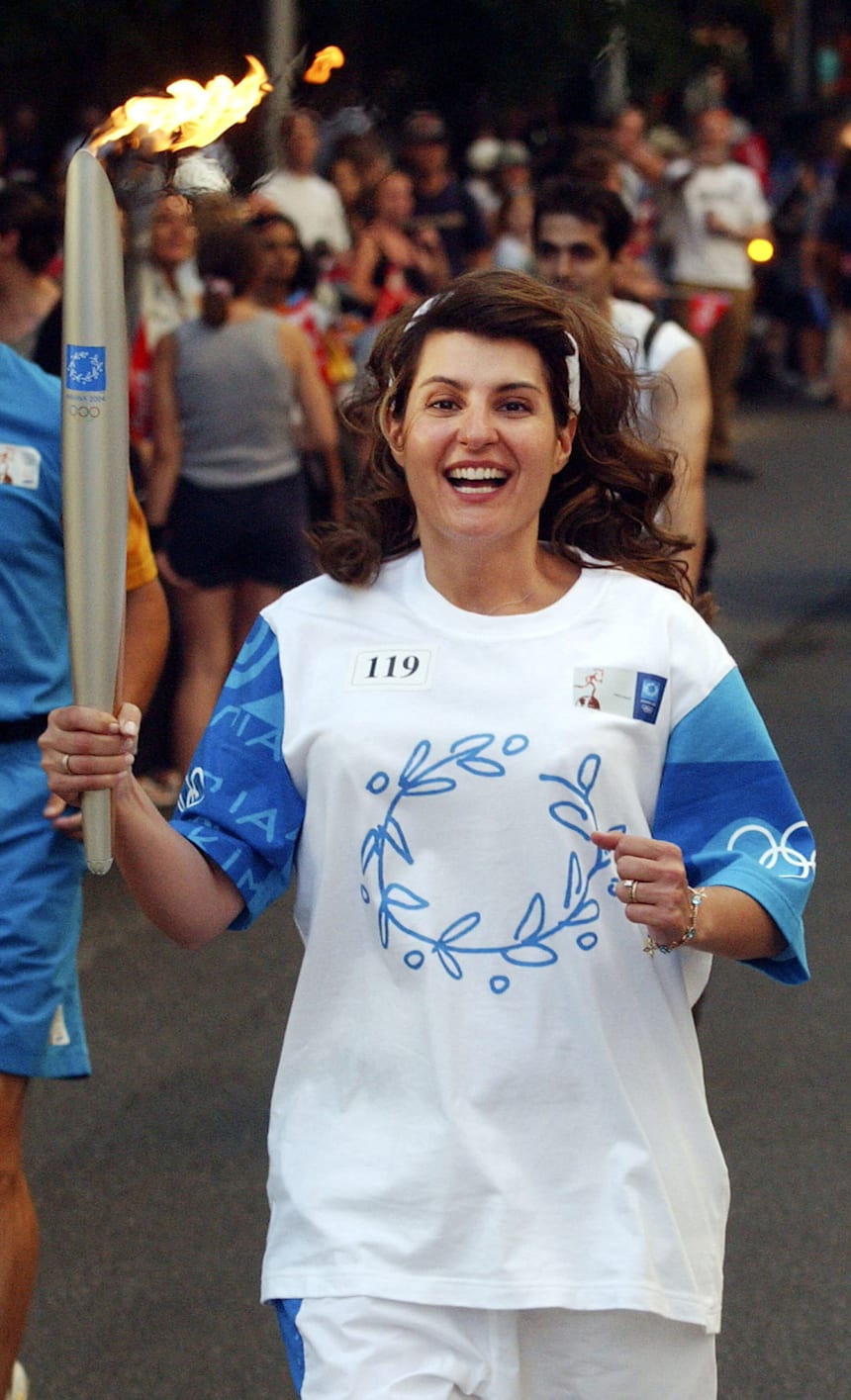
On its way to Beijing in 2008, the torch made it right to the top of the world, with a team of climbers taking it to the summit of Everest via the Chinese side. Prior to that the flame had travelled the five continents andbeen relayed through 19 major cities, including St Petersburg, London, Paris, San Francisco, Buenos Aires, New Delhi, Bangkok, Dar es Salaam, Canberra, Nagano and Seoul.
After then arriving at Hong Kong, it passed through 31 Chinese provinces and autonomous regions beforereaching Sichuan, which had been hit by a devastating earthquake on 12 May. Then, at the end of an OpeningCeremony held at the Bird’s Nest on 8 August 2008, and which had got under way at 8.08 p.m. on the dot, thefinal torch-bearer, legendary Chinese gymnast Li Ning, was hoisted on a cable up to the giant screen encirclingthe stadium roof. After completing a full airborne lap of the stadium, he lit the cauldron to the roars of thecrowd.
The London 2012 Torch Relay, the last before Rio 2016, began with an eight-day tour of Greece and continued atLand’s End, the extreme southwestern point of the British Isles, with sailing icon Ben Ainslie the first tobear the torch in a Relay that featured a cast of runners dressed all in white and which went by the name of“Moment to Shine”. Unfolding on water (in myriad craft that included rowing boats, yachts and steamships), rail, road and by air, it followed a course that passed within no more than an hour of 95 percent of thepopulation of the UK, the Isle of Man, Jersey and Guernsey.
On the day of the Opening Ceremony, the flame was ferried from Tower Bridge to the Olympic Stadium byspeedboat, with David Beckham and the young footballer Jade Bailey clutching the torch, which they then passed onto five-time Olympic rowing champion Sir Steven Redgrave. Symbolising the generational handover, he then passedthe flame on to seven young athletes aged between 16 and 19 (Callum Airlie, Jordan Duckitt, Desiree Henry, KatieKirk, Cameron MacRitchie, Aidan Reynolds and Adelle Tracey), who had the honour of lighting a cauldron formed by204 copper petals representing all the nations taking part at the Games.